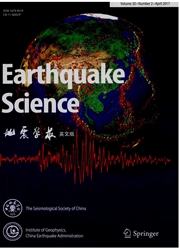

 中文摘要:
中文摘要:
The lithospheric magnetic field(LMF) in China and its surrounding are calculated using the spherical harmonic coefficients given by the NGDC-720 model. The LMF comes from the magnetization of minerals in the crust and in the uppermost mantle. It may, therefore, provide unique insight into lithospheric tectonic processes and mechanisms. Here, we study the geomagnetic manifestation of active tectonic blocks, and find a close correlation between the LMF and seismicity. Many large faults are found to closely overlap with magnetic anomalies, or are distributed along the boundaries of magnetic anomalies.Earthquakes in these fault regions have occurred on the boundaries of magnetic anomalies, or in the transition zones between positive and negative anomalies. We analyze the components of the LMF, and the LMFs at different altitudes, finding that the vertical component, Bzat200 km, is the most related to seismic activity. Relevant physical mechanisms are also discussed. We propose that the stress or viscosity differences caused by temperature variations, which manifest in the LMF, may be the predominant reason for the correlation between the LMF and seismic activity along large faults.
 英文摘要:
英文摘要:
The lithospheric magnetic field (LMF) in China and its surrounding are calculated using the spherical har- monic coefficients given by the NGDC-720 model. The LMF comes from the magnetization of minerals in the crust and in the uppermost mantle. It may, therefore, provide unique insight into lithospheric tectonic processes and mechanisms. Here, we study the geomagnetic manifesta- tion of active tectonic blocks, and find a close correlation between the LMF and seismicity. Many large faults are found to closely overlap with magnetic anomalies, or are distributed along the boundaries of magnetic anomalies. Earthquakes in these fault regions have occurred on the boundaries of magnetic anomalies, or in the transition zones between posilive and negative anomalies. We ana- lyze the components of the LMF, and the LMFs at different altitudes, finding that the vertical component, Bz at 200 kin, is the most related to seismic activity. Relevant physical mechanisms are also discussed. We propose that the stress or viscosity differences caused by temperature variations, which manifest in the LMF, may be the pre- dominant reason for the correlation between the LMF and seismic activity along large faults.
 同期刊论文项目
同期刊论文项目
 同项目期刊论文
同项目期刊论文
 期刊信息
期刊信息
